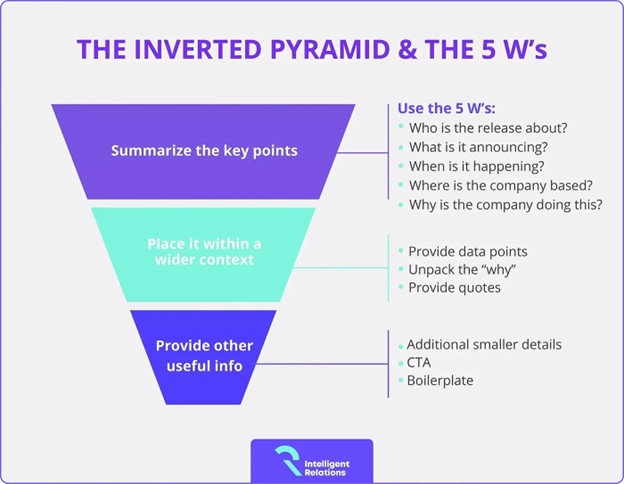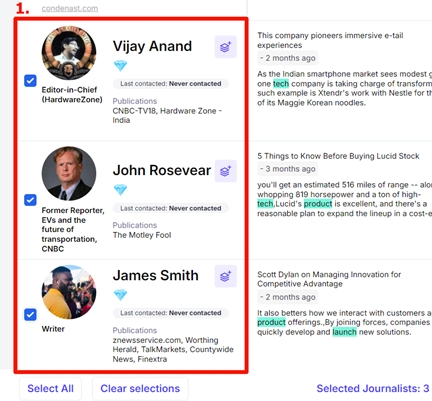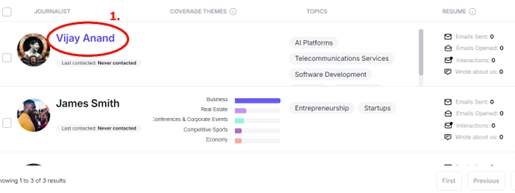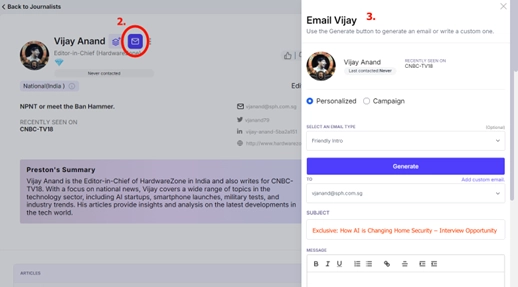The Ultimate Press Release Submission Guide How to Send a Press Release 2025: The Ultimate Guide (+ Examples)
- Home
- Intelligent Insights Blog
- The Ultimate Press Release Submission Guide How to Send a Press Release 2025: The Ultimate Guide (+ Examples)
The ability to craft a newsworthy press release is a necessary PR skill. Unfortunately, it’s only half the battle. To maximize the benefits of your press release, you also need to know how to distribute it effectively.
Whether using a press release distribution service or directly contacting journalists, the press release submission process demands planning and timing.
Direct contact with journalists allows for personalized pitches, increasing the chances of coverage.
Using a distribution service offers a broad reach but requires crafting headlines and summaries that stand out amidst a sea of submissions.
Mastering the process of sending a press release enhances the impact of your announcement and ensures your news receives the attention it deserves. This guide will walk you through the steps.
Here’s what’s covered:
- Sending a Press Release Directly to Journalists
- The Importance of Sending a Press Release
- Using a Press Release Distribution Service
Not sure which submission strategy is best for your press release?
Book a free consultation with one of our PR experts. We’ll take a look at what you’ve got and let you know how to successfully submit your press release for the best results.
The Importance of Sending a Press Release
Sending a press release is a powerful way to generate media coverage and build brand visibility. It allows businesses, organizations, or individuals to communicate important news, product launches, or events to the public in a professional and structured format.
A well-crafted press release helps you gain credibility, increase your reach, and capture the attention of journalists, bloggers, and media outlets. It’s a direct way to share your story, control your narrative, and influence how your message is presented to your target audience.
Pro Tip: By sending a press release, you not only boost your chances of media exposure but also create opportunities for enhancing your brand’s reputation and expanding its influence in your industry.
Learn more about successful press release submissions here: How to Successfully Submit a Press Release
Using a Press Release Distribution Service
A press release distribution service is often an efficient way to get your news in front of a wide audience, but it comes with both advantages and drawbacks.
According to this Early Stage Marketing (ESM) survey, 96% of PR professionals say direct contact via email is the most effective method for pitching media contacts.
Let’s take a look at the pros and cons:
Pros
Using a press release distribution service is a quick and easy option, sometimes guaranteeing a certain amount of media coverage. Some advantages include:
- Broad Reach: Distribution services send your press release to hundreds of media outlets, ensuring your story reaches a large, diverse audience.
- Time-Saving: These services streamline the process, saving you the time and effort of manually reaching out to journalists.
- Targeting Options: Many services allow you to target specific industries or geographical regions, enhancing relevance.
Cons
Using a service is impersonal and doesn’t allow you to create lasting personal relationships with journalists, which is extremely valuable in the long run. Other disadvantages include:
- Cost: Some distribution services are expensive, especially for smaller businesses or startups.
- Less Personalization: Press releases sent through a service lack the personal touch of directly pitching journalists.
- Competition: Your release competes with many others, making it harder to stand out.
Pro Tip: To maximize effectiveness, choose a distribution service that allows you to customize your pitch and target niche outlets in your industry.
For more information on press release distribution services, read our article: Your Guide to Press Release Distribution Services
Sending a Press Release Directly to Journalists
Sending a press release directly to journalists significantly increases your chances of media coverage. It allows you to target the right people with the right message.
While it may seem daunting, following a clear process ensures your announcement gets noticed.
Here’s a step-by-step guide to doing it effectively:
Step 1: Write a Compelling Press Release
Before contacting journalists, you need a well-crafted, AP style press release. A good press release should follow The Inverted Pyramid structure and answer The 5 Ws (who, what, when, where, why).

Example Structure
- Headline: Local Startup Revolutionizes Home Security with AI Technology
- Opening Paragraph: Tech Innovations, a local startup, has launched a groundbreaking AI-powered home security system designed to offer unparalleled protection. The new system uses advanced algorithms to detect intrusions with 98% accuracy.
- Body: Expand on the details, including quotes from leaders in your organization, data, and statistics that support your claim.
- Call to Action (CTA): Let journalists know what to do next (e.g., schedule an interview, attend an event, etc.).
- Boilerplate: Provide a brief description of the company’s mission, key services or products, and notable achievements, offering context to journalists and readers.
- Contact Information: Provide your media contact’s name, email, and phone number.
Pro Tip: Keep it concise — no longer than one page. Make sure the headline is eye-catching and the opening paragraph covers the 5 Ws.
Want more details on crafting a press release that gets results? Read our article: How to Write a Press Release for Great Results [Examples + Tips]
Step 2: Research and Build a Media List
Not all journalists will be interested in your press release. The key is targeting those who cover your industry or topic.
To build a media list:
Identify the Right Journalists
Let’s say you’re launching a new tech product, and you want to target tech journalists and publications. Here’s what you do:
- Go to Media Database and select Search Journalists.
- Enter relevant search terms.
- Apply filters to refine your search.



Pro Tip: To get search results for tech journalists and media outlets in a specific area, refine your search to something like “Tech product launch AND Boston.”
Create and Organize Your List
Keep track of journalists’ names, emails, and publication details. Also, note any specific angles they seem to prefer, so you can tailor your message accordingly.
- Select the most relevant journalists.
- Add selected journalists to your list.
- Keep track of your saved journalists in My Lists.
- Organize them into categories for efficiency.



Step 3: Personalize Your Email
Journalists receive a ton of press releases daily, so personalization is key to making yours stand out. Instead of blasting out the same email, take your time and tailor emails for specific journalists.
Subject Line
The subject line should be concise and attention-grabbing. For example, Exclusive: How AI is Changing Home Security – Interview Opportunity
- Click on the Journalist’s name.
- Next, click on the email icon.
- Input your headline and email content.


Email Body
In the body of your email, you should:
- Greet the journalist by name.
- Briefly mention why their previous work makes you think they’d be interested (e.g., “I enjoyed your recent article on AI in consumer tech”).
- Summarize your press release in a few sentences.
- Offer exclusivity if possible. Journalists appreciate receiving stories before their competitors.
- Attach your press release or paste it at the end of your email.
- Include a clear CTA (e.g., “Would you be available for an interview next week?”).
Step 4: Follow Up
Following up is essential after sending your press release but must be done tactfully. Wait a few days, then send a polite follow-up email.
Don’t be pushy or overbearing.
Follow-up Example
Here’s an example of a standard follow-up. Note the length, brevity, and congeniality.
Hi [Journalist Name], I wanted to follow up on the press release I sent regarding Tech Innovations’ new AI-powered home security system. I’d love to know if you’d be interested in covering this story. Feel free to reach out with any questions or if you’d like to schedule an interview.
Bonus Tips
Here are some additional tips to keep in mind during the 4-step sending process:
- Keep it Brief: Journalists are busy, so get to the point quickly.
- Respect Their Preferences: Some journalists may prefer pitches via Twitter DMs or LinkedIn, while others strictly use email.
- Track Responses: Use tools like Google Sheets or a CRM to track which journalists respond, who to follow up with, and what feedback you receive.
- Provide Visuals: Including high-quality images or videos with your press release can make your story more attractive.
For more information on PR media databases, read our article: Unlocking the Power of the PR Media Database: A Comprehensive Guide
Key Takeaways
Whether you send your press release through a distribution service or directly to journalists and media outlets, both methods have their advantages.
Distribution services offer broad exposure, automation, and access to established media networks, making it ideal for large-scale announcements.
Submitting your press release to targeted journalists directly allows for a more personalized approach, helping you build relationships and gain coverage from those most likely to find your story relevant.
Ultimately, the best approach depends on:
- Your Goals
- Your Budget
- The Nature of Your News
A combination of both methods maximizes your reach while ensuring your message is tailored to the right audiences.
Whichever route you take, ensure your press release is well-crafted, concise, and newsworthy. Provide journalists and readers with a clear reason to engage with your story.
Follow the examples and tips laid out in this guide, and you’ve got this! Still not sure? Just book a free consultation with us for expert insights into maximizing your press release’s impact.

